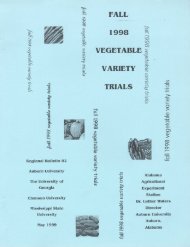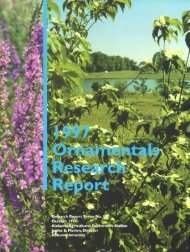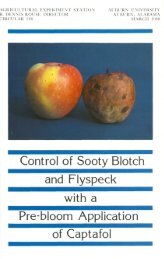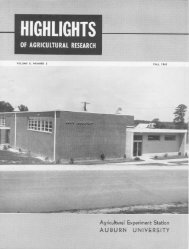MARKETING CHRISTMAS TREES - Auburn University Repository
MARKETING CHRISTMAS TREES - Auburn University Repository
MARKETING CHRISTMAS TREES - Auburn University Repository
You also want an ePaper? Increase the reach of your titles
YUMPU automatically turns print PDFs into web optimized ePapers that Google loves.
<strong>MARKETING</strong> <strong>CHRISTMAS</strong> <strong>TREES</strong> 5<br />
wholesale and retail prices, and problems encountered by retailers<br />
and wholesalers in their Christmas tree operations.<br />
All three Alabama cities having over 100,000 population were<br />
included in the study. Chosen at random as samples were: 1 of<br />
the 2 cities of about 50,000 population, 1 of the 7 cities of 20,000<br />
to 49,000 population, 1 of the 6 cities of 10,000 to 19,000 population,<br />
and 3 of the 30 cities of 5,000 to 9,000 population. In addition,<br />
Decatur (about 20,000 population) and Demopolis (about<br />
5,000) were selected arbitrarily because of their location in areas<br />
of cedar-producing, lime lands.<br />
An attempt was made to obtain records from all types of retailers<br />
in the cities studied. However, they varied from individuals<br />
selling for only a day or two or when convenient to long established<br />
chain stores. Thus it was not feasible to obtain information<br />
from any predetermined portion of the retailers or of retail sales.<br />
Records were obtained for the most part during the 2 weeks preceding<br />
Christmas. However, additional information was obtained<br />
after Christmas where sellers could be readily located.<br />
<strong>CHRISTMAS</strong> <strong>TREES</strong> OFFERED for SALE in ALABAMA<br />
The number of Christmas trees offered for sale in Alabama in<br />
1956 is not known. Since Alabama has a higher-than-average percentage<br />
of her population in low income brackets, it may be that<br />
her Christmas tree-population ratio is likewise below average,<br />
since the Christmas tree tends to be a luxury item or at most a<br />
"conventional necessity." At the national rate of consumption,<br />
the number of trees used would have been about 690,000. Despite<br />
the low income influence, it seems probable that over a half<br />
million were used in the State. Of course, many trees were cut<br />
from the family farm, or obtained by "gift" or "appropriation." In<br />
Tuskegee, a city of about 6,000, retailers reported offering for sale<br />
1,211 trees and practically all were sold. Thus, their reported<br />
tree-population ratio was near the national average, even though<br />
the enumeration of trees was quite incomplete. On the other<br />
hand, the total number of trees reported offered in the 8 other<br />
small cities was about 1,300. The population sum of these same<br />
cities was about 21,000 giving a ratio of the reported trees to<br />
population of less than one-fifteenth tree per person. Reports,<br />
however, were too incomplete to be used in estimating anything<br />
except the minimum tree-population ratio in any city. Undoubtedly,<br />
sales within the State in 1956 included at least 60 per cent
















